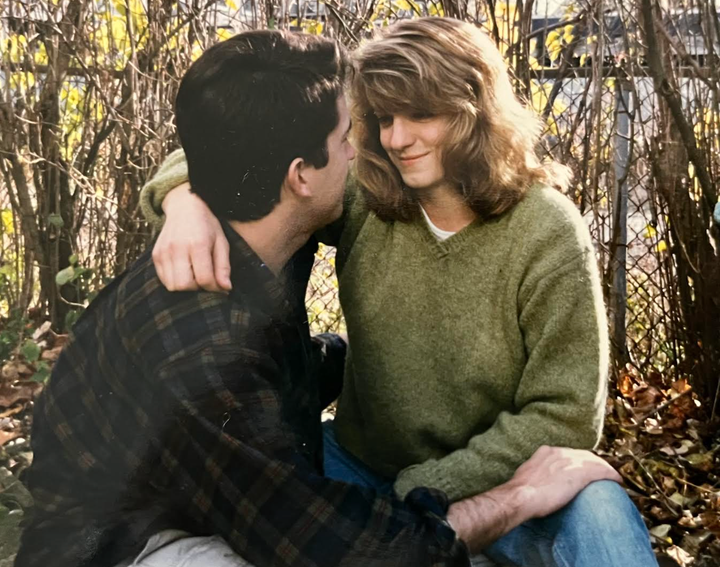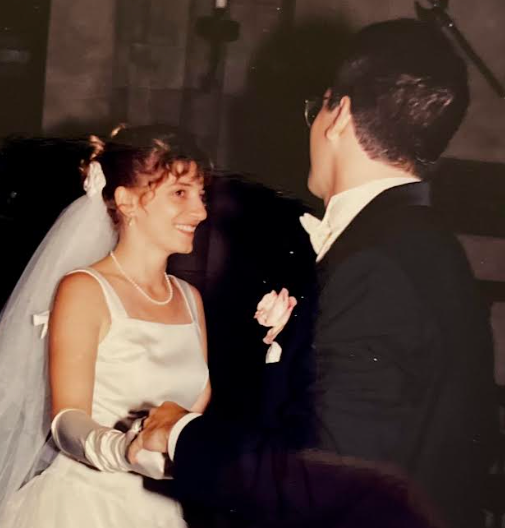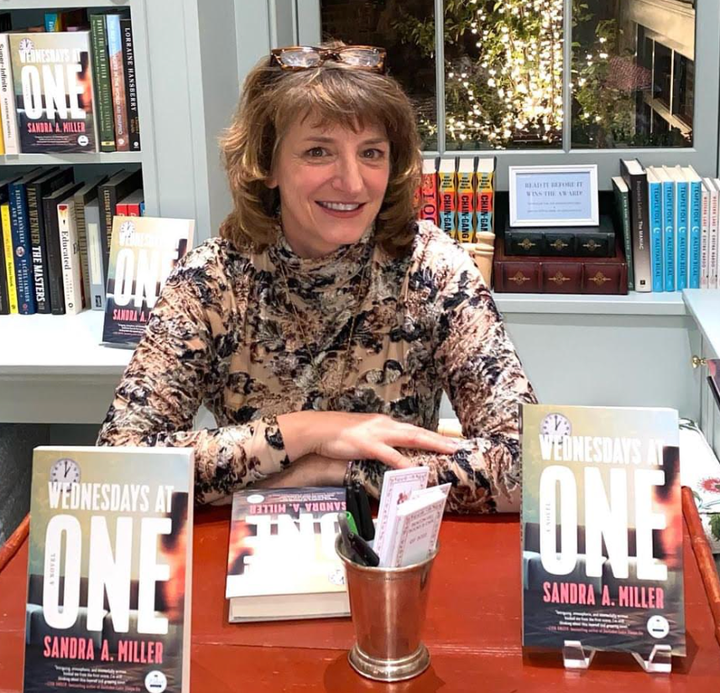
On a hot July evening almost 30 years ago, my then-boyfriend (now-husband), Mark, and I were in his second-floor apartment kitchen, chatting and laughing as he ironed a week’s worth of shirts for his job as a clinical psychologist at a Boston psychiatric hospital. What should have been a sweet Sunday night — Red Sox game on the radio, me cooking pasta — would become the start of our horror story.
The next morning, Mark, fresh from a therapy session, called me, his voice trembling. “One of my clients was spying on us last night. She was listening to our conversation from under the window.”
When Mark told me that she asked about taking him to a Red Sox game and wanted to know what I’d been cooking for dinner, I was concerned but not panicked. Whatever this was, I figured Mark could handle it. Didn’t the occasional client develop a crush on my handsome boyfriend with a warm voice and quick wit? I assumed that with a few more sessions, this would be solved. As a writer, I was even intrigued and imagined the premise of a novel: A woman goes into a therapist’s office and knows things about him that she shouldn’t.
A few days later, I teased Mark about his “stalker,” but he didn’t crack a smile. I took stock of his seriousness as he explained that he was getting a professional consultation and had switched her to another therapist. Apparently, Mark had already been dealing with her burgeoning crush for months but had not foreseen this full-blown obsession. Then she started filling his work voicemail with professions of love, declaring her need to be with him or not live.
“Not live?” I repeated. “Would she actually do something that drastic?”
Mark shook his head. He didn’t know what she was capable of and, for my safety, advised me to watch out for a woman in her late 40s, short, thin, with straight brown hair to her shoulders. She was divorcing her husband and claimed to have nothing to live for. What she did have was money and time on her hands to pursue her 17-year-younger obsession: my boyfriend.
It sounded creepy, but it didn’t fully hit home until that Saturday. Mark and I returned from an afternoon shopping trip to find 16 messages on our answering machine. We listened as a high, pleading voice echoed in the foyer. “Mark, this is Susan. I love you. I’m sorry, Sandra, but I would be lying if I pretended this wasn’t true ...”
We exchanged a questioning look. How had she gotten Mark’s unlisted number? This was 1995, before you could find everything online. It would be a while before we realised she had stolen a phone bill from his mailbox. We continued to listen as 15 more messages played through, each building with intensity until they reached a crescendo of sobs and pleas that went into another realm of fixation, far beyond the benign client-with-a-crush I’d been imagining. I finally realised this was not something that could be managed with reassurance and talk therapy. We were dealing with a serious situation and someone who needed attention from a mental health professional. (Note: Some names and identifying details have been changed to protect privacy.)
Mark warned me against ever speaking to her when she called. Beyond that, for reasons having to do with professional confidentiality, he almost never spoke about her, which means I didn’t know that she was threatening to have her brothers beat Mark up if he didn’t go back to working with her. I also didn’t know the extent of the pornographic messages she was leaving for him at work until she started leaving them on our home machine, too.
Mark didn’t change his phone number because he was about to move in with me. So I changed my number to an unlisted one, and we naively thought a new residence was going to keep her away. If only.

It’s likely that she followed him to our first-floor apartment and then found her way into that mailbox, this time stealing my phone bill. About 50 calls came each day when we were at work. When we were home, the phone rang nonstop. If I answered, Susan hung up. We changed our number again and asked AT&T to leave our number off the bill, but an employee told us the company could not issue bills without a phone number printed on them. We had our landlord cut a mail slot in our door and, for a few days, thought we’d beaten her system.
Then neighbours started to report a woman regularly climbing over their fences and bolting across their yards. I was furious — and scared. Susan loved Mark too much to hurt him, but I didn’t know how she felt about hurting me. It seemed she did want to hurt herself if she couldn’t have Mark. We obviously didn’t want that, and we also knew that if she self-harmed, her family could register complaints with the licensing board and file a lawsuit against any of her therapists — including Mark.
There was a side of me that felt sorry for her. I knew she would never be this abusive if she weren’t suffering from her own mental health issues. Her instinct to invade our lives in the name of love came from her own pain. But she was so horribly invasive that it was hard to keep my anger in check.
Almost as bad as Susan’s intrusiveness was how she infected our once happy relationship. The stress of being stalked led us to argue more and enjoy each other less. We stopped relaxing on our back porch. We kept our windows shut. Even worse than feeling imprisoned in our home was how she was hurting us as a couple.
Mark explored every legal measure to keep her away, but the law doesn’t always support the innocent. Criminal restraining orders are limited to significant others, relatives and people you’ve lived with. Civil restraining orders require that you pay a large sum of money and make at least three court appearances with the very person you’re trying to avoid. That was what Susan wanted: to see Mark however she could. Instead of a restraining order, we had our local police on speed dial, hoping they’d catch her trespassing. Mark also got friendly with the security force at his hospital, where Susan, despite having been banished from the grounds, was chronically sneaking into his office building.
Even when she wasn’t around, she was around. I was alone in bed one summer night when the door creaked open. I started shrieking and beating at the darkness with a pillow, shouting, “Get the hell out of our house!” It was the breeze that had blown the door open.
Susan sent effusive bouquets of flowers that we weren’t allowed to accept. Once she mailed us two concert tickets for Shawn Colvin, one of my favourite performers.
“I want to go,” I said tentatively to Mark, feeling entitled to some compensation for all I’d put up with.
Mark looked at me apologetically and tucked the tickets in the file we’d been keeping for the police. “Who do you think is in the seat next to ours?” he asked.
Next, Susan enrolled us in the Harry & David Fruit of the Month club, but Mark said we had to call the company and cancel the subscription, which I did. When four individually packaged Asian pears arrived anyway the following month, Mark, delirious with stress, accused me of not cancelling it and using his stalker to my fruit-loving advantage.
“For fucking pears?” I said sarcastically. “Those were definitely worth every minute that woman has spent trying to ruin our lives.”
We managed to get engaged in the middle of this ordeal — a testimony to the strength of our love in the face of incessant harassment. We proposed to each other on a trip to Canada and couldn’t wait to get home and share our news. When we arrived at our door, we found one of the front porch windows had been broken and the glass pieces were taped back together. I started to shake. She’d been in our house.
With that, we were done and hired a lawyer.
Susan was warned that if she ever came near our home again we were pressing criminal charges. She responded by saying she would die by suicide on our porch. True to her word, she showed up at our door a few nights later and rang the bell. Trembling, I peered out the peephole for my first clear view of the woman who had spent years trying to ruin our lives. She looked pathetic, worthy of pity, but all I could think was I despise you.
I called the police, but Susan threw herself in her car just as they arrived. She led them on a high-speed chase that culminated on a dead-end street. The police found her purse full of pills, a love note to Mark and a knife. They also found Mark’s scuba diving license with his photo in her wallet. He’d always wondered why it had never arrived in the mail after the diving company assured him they had sent it.
After months spent categorising answering machine tapes, love letters, therapy notes and other extraneous evidence, the case went to trial. The most memorable moment for me was when the district attorney looked Mark in the eye and said, “I hope you never in your life have to deal with this woman again.”

With Susan receiving a sentence of two years — most of which were spent in a psychiatric hospital — followed by two years of ankle-monitored parole, we had a beautiful wedding and honeymoon year. During that time, our son was born, and we moved into our own home.
Then it happened. A call. A hang-up. A harassing message. Parole was over, and Susan was back. This time she was claiming Mark had had sex with her when he was her therapist and she was going to sue him for malpractice. Her obsession had flipped to hatred — and vengeance.
The calls went on for weeks, during which I was often numb with fear — and too busy and tired to face this again. Then one day Mark was out with our son, and he saw Susan’s car tailing him. He drove directly to the police station, where an officer chased her and wrote her up for stalking. In court that Monday, she appeared before the same judge who had sentenced her the first time. “I don’t like people coming back for the same offence twice,” he said. Susan received five more years of probation.
Even with Susan gone again, the effects lingered. A ringing phone. The doorbell. A knock on the door in the middle of the day. Any reminder could cause me to go into fight-or-flight mode. But I didn’t want to give that woman any more of my energy, time or joy. She had taken enough from our family. So I did what I do to process traumatic experiences: I wrote about it.
But as diligently as I tried to turn the stalking story into a novel, I couldn’t make Susan into an interesting fictional character. On the page, she was flat and pathetic, just as I saw her in life. Recognising I was still too close to the story, I set the unfinished book aside.
Years would go by, and my memories of Susan would fade with the fullness of our family life. What I didn’t realise, however, was that the fictional seed I had planted all those years ago still lay dormant.
Then the pandemic struck.
In the eerie isolation of the summer of 2020, my fear of COVID-19 triggered another old fear, and Susan was in my head again. The seed of our stalker story had germinated and was on its way to bearing fruit. Twenty-three years after we last heard from Susan, I had enough distance from the trauma to go back to my novel. This time the troubled psychologist became my protagonist, and Susan turned into a far more compelling and complex character than a single-minded stalker.
I realised how deeply Susan had affected me. Though I would never wish to go through that ordeal again, I also recognised that what happened to me shaped who I am, and it was up to me to decide how I moved forward. I’m not a better person for having been stalked — I wouldn’t wish that on anyone — but I did take that trauma and find a way to work through it. Years after it happened, I took control of the situation in a way that I couldn’t when Susan was tormenting us. Then I used that control to create something I’m incredibly proud of.
In just three months, my debut novel, “Wednesdays at One,” almost wrote itself.
This past summer, I chose Mark as my conversation partner for my book launch, because this felt like our story to tell together. That evening, as I held my published book in my hand with the cover image of a hazy woman fleeing a therapy office, I told the crowd at Harvard Book Store how a long-ago stalker had inspired my novel. I didn’t give the sensational details of our ordeal, but I focused instead on the takeaway truth: Our most painful lived stories can be unexpected gifts. It’s our job as writers to turn that trauma into art.
Sandra A. Miller’s debut novel, “Wednesdays at One,” is a USA Today bestseller. She is also the author of the award-winning memoir “Trove: A Woman’s Search for Truth and Buried Treasure.” She lives outside of Boston and teaches writing at the University of Massachusetts, Lowell.